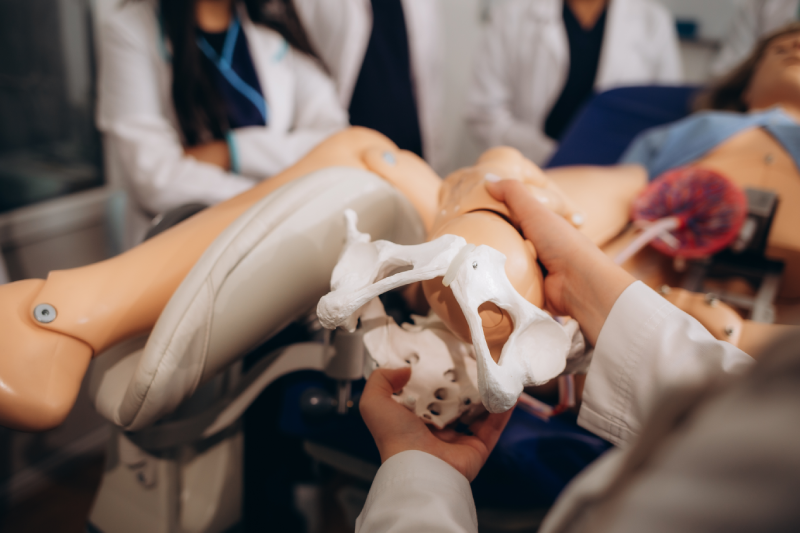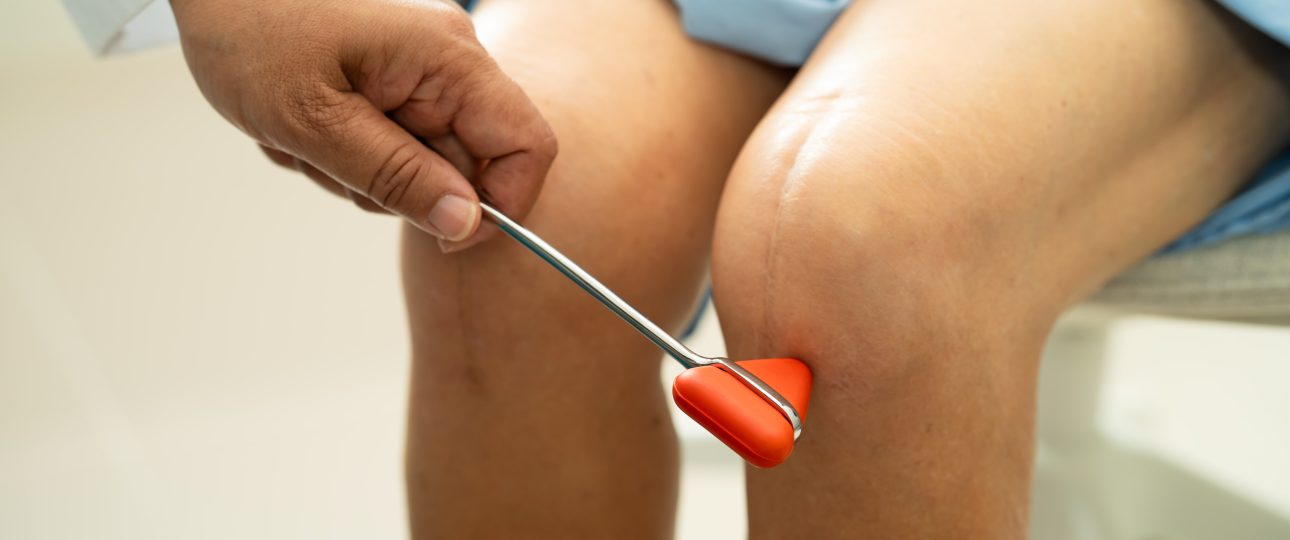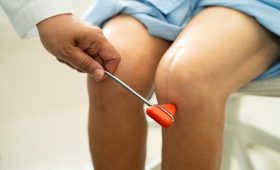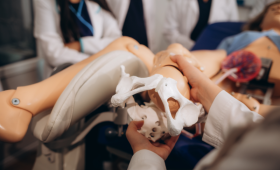What is Bilateral Knee Replacement Surgery?
Bilateral knee replacement surgery is the simultaneous replacement of the damaged surfaces of both knee joints with artificial prostheses. It is typically performed in cases where the knee joints have lost their function due to conditions such as advanced osteoarthritis or rheumatoid arthritis. This operation aims to alleviate the patient’s unbearable pain, increase mobility, and significantly improve their quality of life by allowing both knees to enter the recovery process at the same time. Repairing two joints in a single surgical procedure can shorten the patient’s total recovery time and enable them to regain full mobility at once.
Why is Replacing Both Knees at the Same Time Preferred?
Replacing both knees at the same time is a comfortable option for patients who have advanced damage in both knees. It means a single surgery, a single dose of anesthesia, and a single recovery period. This halves the total time the patient needs to spend in the hospital and for recovery. Furthermore, simultaneous prosthesis placement in both knees helps to regain walking and balance functions more symmetrically and quickly. This method speeds up the patient’s return to daily life by improving their quality of life in a short time.
What Are the Advantages of Bilateral Knee Replacement Surgery?
The main advantages of bilateral knee replacement surgery include repairing both knees with a single operation, a shorter total recovery period, and a shorter hospital stay. The patient only undergoes one surgical trauma, which makes the physical therapy process more efficient. Both knees becoming functional at the same time provides symmetry in walking and movement ability. Additionally, since it is a single surgery, the overall cost may be lower than the total of two separate surgeries.
What Are the Risks of Bilateral Knee Replacement Surgery?
Bilateral knee replacement surgery has some risks. The most important risk is the increase in blood loss and the duration of the surgery. This can raise the anesthesia risk, especially in elderly patients or those with chronic illnesses. Other potential risks include infection, blood clot formation, and anesthesia-related complications. However, thanks to advanced surgical techniques and modern anesthesia methods, these risks are minimized. The surgeon makes the decision about the surgery by evaluating the patient’s overall health.
What is the Cost of Bilateral Knee Replacement Surgery in Turkey?
The cost of bilateral knee replacement surgery in Turkey varies greatly depending on the type of prosthesis used, the quality of the hospital, the surgeon’s experience, and the complexity of the operation. Generally, these surgeries are more economical compared to similar operations in Europe and North America. Prices are usually offered in packages that include the surgery fee, anesthesia, hospital stay, and initial post-operative check-ups. For accurate and up-to-date cost information, it is recommended to get information from reliable health consulting centers like Cure Holiday.
Why Are the Costs More Affordable Compared to Other Countries?
There are several reasons why the costs of bilateral knee replacement surgery in Turkey are more affordable compared to other countries. Firstly, lower general operating expenses and labor costs affect the prices. Additionally, the value of the Turkish Lira against foreign currencies creates attractive prices for international patients. However, these affordable prices do not mean that the quality of service is compromised. Many hospitals provide services that meet international standards and use the latest technology.
What Does the Surgery Price Include?
Bilateral knee replacement surgery price packages are generally prepared to cover the pre-operative, intra-operative, and post-operative stages. What is usually included in these packages are: the surgical fee, anesthesia fee, hospital stay, the cost of the prostheses used, post-operative check-ups, and the initial physical therapy sessions. Some comprehensive packages may also include airport transfers, accommodation, and interpretation services. These packages make the treatment processes for international patients smoother.
How Long Does the Surgery Take?
The duration of bilateral knee replacement surgery is almost twice that of a unilateral surgery. On average, this operation is completed in 2 to 4 hours. The duration can vary depending on the extent of the damage to the patient’s knee joints, the surgeon’s experience, and any additional conditions that may arise during the operation. This longer duration ensures that the surgeon works meticulously on both knees and places each prosthesis in the most suitable way.
How Long is the Hospital Stay?
The hospital stay after bilateral knee replacement surgery may be slightly longer compared to unilateral surgery. Generally, patients stay in the hospital for 3 to 7 days. During this period, the patient is closely monitored by the healthcare team for post-operative pain management, physical therapy support, and basic mobility exercises. The patient’s overall health and recovery speed are the most important factors influencing the decision to discharge.
What is the Post-Surgery Recovery Process Like?
The post-operative recovery process involves an intensive physical therapy program to regain knee mobility and strengthen the muscles. In the first few days, pain and swelling are normal, but this can be controlled with medication. Patients usually start walking immediately after the surgery. The process of full recovery and returning to normal life varies depending on the person’s age, health status, and commitment to the physical therapy program.
When Can I Start Walking?
After bilateral knee replacement surgery, patients usually start walking with the assistance of a physical therapist a day after the surgery. The first walks are done with the help of a walker or crutches. This early mobilization increases blood circulation and reduces the risk of blood clots. Thanks to both knees healing at the same time, the patient starts to regain walking symmetry in a short time.
When Does Physical Therapy Start and How Long Does It Last?
Physical therapy begins immediately after the surgery, usually within the first 24 hours. In the initial stage, the physical therapist performs passive range of motion exercises to increase the knee’s range of motion. Later, the patient progresses to active exercises they can do on their own. The physical therapy program generally continues for 3 to 6 months, but full functional recovery can take up to a year. This process is of vital importance for the success of the surgery.
What Should Be Considered Before Surgery?
Before the surgery, the patient’s overall health is evaluated in detail. It is necessary to quit smoking and alcohol use, stop blood-thinning medications as recommended by the doctor, and eat a healthy diet. Additionally, strengthening the muscles with light exercises before the surgery can speed up the recovery process. It is important for the patient to get detailed information about the surgical process and ask all potential questions to the surgeon.
What Tests Are Done Before Surgery?
A series of tests are performed before the surgery to determine the patient’s general health status. These usually include a blood count, biochemistry tests, bleeding and clotting time, electrocardiogram (ECG), and a chest X-ray. These tests help the anesthesiologist and the surgeon decide whether the surgery is safe. Full information about any chronic illnesses and all medications used should be provided.
What Type of Anesthesia is Used During Surgery?
Bilateral knee replacement surgery is generally performed under general anesthesia. This ensures that the patient is completely asleep throughout the surgery and feels no pain or discomfort. In some cases, in addition to general anesthesia, regional anesthesia (nerve block) can also be used. This facilitates post-operative pain management. The anesthesiologist decides on the most suitable anesthesia method by evaluating the patient’s overall health.
Who is Suitable for Bilateral Knee Replacement Surgery?
Patients with advanced pain, limited movement, and loss of function in both knees are suitable candidates for bilateral knee replacement surgery. Additionally, their general health status should be suitable for the surgery, and the anesthesia risk should be low. The patient being young and healthy can speed up the post-operative recovery process. The surgeon evaluates the patient’s condition and decides on the most suitable treatment method.

Is the Situation Different If One of My Knees is Worse Than the Other?
One knee being in a worse condition than the other does not prevent bilateral surgery. On the contrary, placing prostheses in both knees at the same time helps the patient achieve better walking symmetry and balance. The simultaneous healing of both knees prevents one knee from bearing the load of the other. This allows the patient to move in a more balanced and pain-free manner.
Can I Have Knee Replacement Surgery at Different Times?
Yes, patients can have bilateral knee replacement surgery at different times. Usually, there is a waiting period of 3 to 6 months between the two surgeries. This option is more suitable for patients who are worried about the risks of the surgery or do not feel ready for a single operation. However, in this case, the patient undergoes separate preparation, surgical procedures, and recovery processes for both surgeries, which extends the total treatment duration.
How is Post-Surgery Pain Management Handled?
Post-surgery pain management is very important for the patient’s comfort and recovery process. In the first few days after the surgery, the pain can be intense, but this is controlled with prescribed pain relievers. The patient is usually given strong pain relievers that can be taken both intravenously and orally. Applying ice is an effective method to reduce pain and swelling. The pain decreases as the recovery process progresses.
How Should I Pay Attention to My Diet After Surgery?
Diet after surgery is of vital importance to support the recovery process. Foods rich in protein (chicken, fish, eggs) support tissue repair, while foods rich in calcium and Vitamin D (dairy products, green leafy vegetables) protect bone health. Drinking an adequate amount of water helps reduce edema. Additionally, it will be beneficial to avoid overly salty, spicy, or processed foods that can negatively affect recovery.
When Can I Return to Normal Daily Life?
Returning to normal life after bilateral knee replacement surgery can be more challenging than after unilateral surgery. However, patients can usually perform their daily activities at home independently within the first few weeks. Returning to desk jobs can happen within a few weeks, while returning to more physically demanding jobs can take 3 to 6 months. Strict adherence to the physical therapy program plays a critical role in speeding up the process.
When Can I Start Exercising?
The process of starting to exercise after surgery varies depending on the person’s recovery speed and the type of sport. Light-paced walks can be started within the first few weeks. It is recommended to start low-impact sports like cycling and swimming after 3 months. For more intense sports like tennis, running, or skiing, it may be necessary to wait up to a year. Avoiding high-impact sports is important to extend the life of the prosthesis.
What is the Lifespan of the Prostheses?
The lifespan of modern knee prostheses used today is quite long. A knee prosthesis is generally expected to function without problems for 15 to 25 years. The lifespan of the prosthesis varies depending on the patient’s age, activity level, weight, and the type of prosthesis. Strict adherence to the physical therapy program and avoiding high-impact activities are the most important factors in extending the life of the prosthesis.
Is There a Risk of Infection?
As with any surgical operation, there is a risk of infection in knee replacement surgery. However, thanks to modern surgical techniques, high hygiene standards applied in operating rooms, and pre-operative antibiotics, this risk is minimized. If symptoms of infection such as fever, redness, or swelling are seen in the post-operative period, you should immediately consult a doctor.
How to Find a Good Surgeon?
It is very important to do comprehensive research to find a good surgeon. Among Orthopedics and Traumatology specialists, surgeons with experience in knee replacement surgeries should be preferred. The surgeon’s past success rates, patient reviews, and whether they offer a detailed pre-operative consultation service are important. Consulting services like Cure Holiday can support you in finding the right surgeon.
What is the Role of Consulting Centers Like Cure Holiday?
Health consulting centers like Cure Holiday manage the treatment processes of international patients from start to finish. These centers help patients find the most suitable surgeon and hospital, organize the surgical planning, and make flight and accommodation arrangements. They also provide interpretation services in the hospital and during the post-operative period, eliminating the language barrier. These services make the patient’s treatment process more comfortable and stress-free.
How Should I Prepare for Travel to Turkey?
Before traveling to Turkey, make sure you have a valid passport and check if a visa is required. It is important to bring all necessary medical reports, test results, and a list of medications. Getting travel and health insurance will also protect you against potential unexpected situations. For detailed information about the pre- and post-travel process, you can contact Cure Holiday.
What is the Experience Like for International Patients?
Turkey has a developed infrastructure in the field of health tourism. International patients not only get treatment but also have the opportunity to explore a country with rich historical and cultural assets. Many hospitals offer all-inclusive packages that also include transfers and accommodation. Thanks to English-speaking patient coordinators, there is no language barrier, and the treatment process proceeds comfortably.
Are There Special Care Instructions for Bilateral Surgery?
Yes, bilateral knee replacement surgery requires special care instructions compared to unilateral surgery. Since the patient needs to protect both knees at the same time, mobility may be more limited at first. Therefore, it is very important to make the home environment safe (removing carpets, non-slip floors) and to have a person to provide support for the first few weeks. The surgeon and physical therapist will give the patient detailed information about special exercise and care instructions.
Is There Bruising on the Knees After Surgery?
Yes, it is quite normal to have bruising and swelling on and around the knees after knee replacement surgery. This is due to tissue damage and bleeding that occurred during the surgery. Bruises usually disappear within 2-3 weeks, while swelling may last longer. During this process, applying cold compresses and keeping the knees elevated helps the bruises and swelling subside more quickly.


